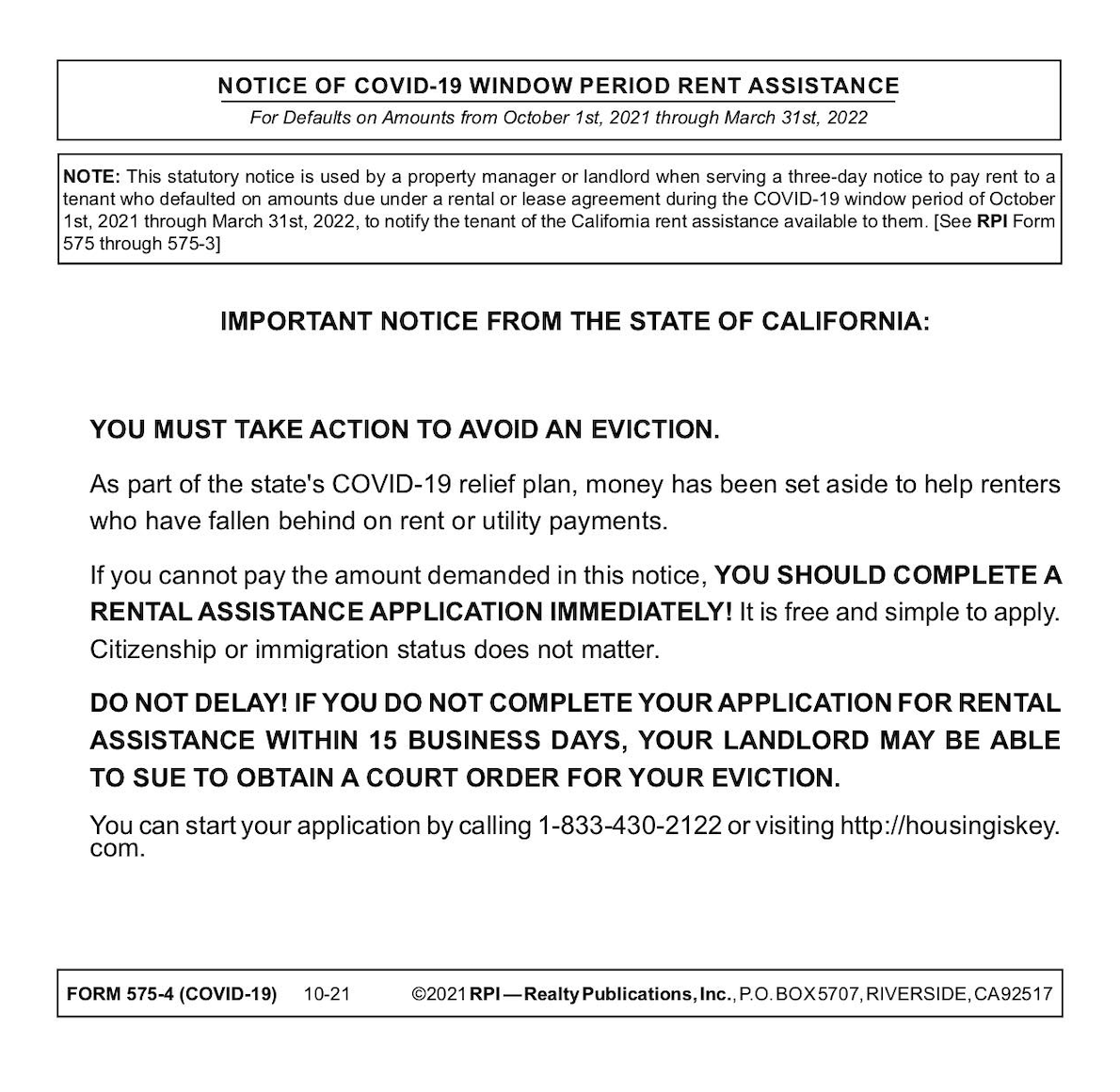After 19 months of eviction protections, California’s eviction moratorium is finally coming to an end.
The Rental Housing Recovery Act (Rental Recovery Act), also known as AB 832, was enacted here in California to extend the eviction moratorium through September 30, 2021.
The Act built on previous legislation to keep tenants housed and prevent the spread of COVID-19. This temporary moratorium prohibited landlords from evicting tenants due to nonpayment of rent that became delinquent between March 1, 2020 and September 30, 2021 due to the tenant’s COVID-19-related financial distress. [Calif. Code of Civil Procedure §116.223]
As we are now at the end of the protected period, what’s next for California tenants facing eviction?
The rent recovery window period
When the tenant becomes delinquent on rent in the period between October 1, 2021 and March 31, 2022, this missed rent is technically referred to as a COVID-19 recovery period rental debt. Here, the tenant experiences a default in rent payment during a “window period” – after the expiration of the Rental Recovery Act, a period of time that deals with the lingering symptoms of the pandemic and recession.
Thus, delinquent rent during this window period is treated differently than the rent targeted under the Rental Recovery Act which accrued between March 1, 2020 and September 30, 2021, known as COVID-19 rental debt.
Unlike COVID-19 rental debt, 25% of which needed to be repaid prior to October 1, 2021 to avoid eviction, window period rent needs to be repaid fully to the landlord. To that end, government rent assistance is available, and the landlord needs to make an effort to receive that assistance before seeking to evict a tenant during the window period. [CCP §1179.11(f)]
Thus far into the distribution of emergency rent assistance (ERA), California landlords have received $526.5 million in assistance to cover on average $11,800 of delinquent rent per tenant. To find out more and apply for rent assistance, see California’s ERA distribution site: Housing Is Key.
Related article:
Landlords, tenants in the dark about Emergency Rental Assistance
New further notice required
During the period in which the Rental Housing Recovery Act was in effect, the typical procedures surrounding service of a notice to pay rent were superseded by a 15-Day Notice to Pay Rent. However, effective October 1st, 2021, the preexisting notices about rent assistance return – with a slight change in procedure.
From the October 1, 2021 through March 31, 2022 window period, landlords seeking to evict a tenant due — fully or in part — to a monetary default on their lease or rental agreement, are to provide the following statutory notice, a sort of cover letter, with their notice to pay rent:

The notice to pay needs to inform the tenant of:
- the amount of rent due and the date each amount became due; and
- the telephone number and website of the appropriate government rental assistance program. [CCP §1179.10(a)]
Further, the landlord needs to give the tenant who does not pay within the three days under the notice to pay rent a further notice to quit – deliver possession – at least three business days before proceeding with an unlawful detainer (UD) action. [CCP §1179.10(a)(1)]
Realty Publications, Inc. (RPI) publishes this new rent assistance notice which is required beginning October 1, 2021. The boilerplate notice is to be printed by the landlord or property manager and included along with the Three-day Notice to Pay being served. The different varieties of the three-day notices are covered in a later section. [See RPI Form 575-4]
Filing an unlawful detainer (UD)
For a UD action to be successful:
- the landlord needs to have filed a complete application for government rent assistance; and
- their application needs to have been denied due to:
- a lack of eligibility;
- a lack of funding; or
- an incomplete application due to the tenant’s failure to complete their portion of the application for at least 15 business days after the landlord completed their portion of the application. [CCP §1179.11(c)]
To properly evict a tenant due to nonpayment of rent during the COVID-19 recovery window period of October 1, 2021 through March 31, 2022, the landlord needs to file one of the following statements:
- a statement verifying:
- the landlord submitted and was denied an application for government rent assistance to cover the delinquent rent prior to seeking to evict the tenant; and
- a copy of the document denying the landlord rent assistance;
- a statement verifying:
- 20 days have passed since the later of:
- the date the landlord submitted the application for rent assistance; and
- the date the landlord served the tenant with a three-day notice to pay rent or quit;
- the landlord has not received notice from the rent assistance program that the tenant has submitted their portion of the application for rent assistance; and
- the landlord has been unable to verify with the tenant that they have applied for government rent assistance; or
- 20 days have passed since the later of:
- a statement that the delinquent rent accrued during a tenancy that began on or after October 1, 2021. [CCP §1179.11(a)]
Landlords’ use of eviction notices
A slew of forms exist for landlords to properly evict tenants in California.
Along with the challenges presented by the noticing requirements during the rent recovery window period, California also has separate requirements depending on the type of eviction through California’s Tenant Protection Act (TPA) enacted in 2020 before the pandemic upheaval.
The TPA requires landlords to have just cause to evict tenants of properties built 15 or more years ago who have been a tenant for 12 months or more. Landlords lacking just cause to evict may need to provide financial relocation assistance, thus making it more difficult for landlords to evict tenants to rent out their properties to new tenants. [Calif. Civil Code §1946.2(a)]
To qualify for an at-fault just cause eviction, the tenant:
- defaulted on a rent payment;
- failed to enter into a landlord-requested renewal or extension of a lease which terminated on or after January 1, 2020 [See RPI Form 565];
- breached a material term of the lease;
- committed or permitted a nuisance or waste to occur on the property;
- conducted criminal activity on the premises or common areas, or used the premises for an unlawful purpose;
- assigned or sublet the premises in violation of the expired lease;
- refused the landlord’s authorized entryinto the premises; or
- failed to deliver possession after providing the landlord notice to terminate the tenancy or surrender possession. [CC 1946.2(b)(1); See RPI Form 576-1]
Landlords seeking to evict a tenant who qualifies for just cause eviction during the rent recovery period due to nonpayment of rent (a curable monetary breach), the landlord serves the tenant with a Three-Day Notice to Pay Rent (with or without related fees). These notices include sections which identify the tenant as being under a lease which requires just cause to terminate the tenancy and indicates their failure to pay rent constitutes just cause for eviction. [See RPI Form 575-2 and Form 575-3]
Editor’s note – All RPI forms within this numerical range have been updated and renumbered as of September 24, 2021.
With either of these notices, the landlord includes the additional cover letter notice concerning the rent assistance available during the window period. This rent assistance notice needs to be delivered with a Three-Day Notice to Pay Rent for delinquencies of rent accruing during the window period from October 1, 2021 through March 31, 2022. [See RPI Form 575-4]
Once the three days have passed and the tenant has still not paid the appropriate amount or communicated with the landlord that they have applied for rent assistance – the landlord may serve the tenant with a Three-Day Notice to Quit without the further opportunity for the tenant to cure the default in payment of rent. [See RPI Form 577-1]
Tenants exempt from just cause eviction requirements
For tenants who are not subject to just cause eviction requirements, the landlord serves the nonpaying tenant with a Three-Day Notice to Pay, along with the notice on the availability of government rent assistance. [See RPI Form 575-1; Form 575-4]
Multi-unit residential real estate exempt from just cause eviction procedures include:
- residential units that have been issued a certificate of occupancy within the previous 15 years;
- a duplex of which the owner occupied one of the units as their principal residence at the beginning of the tenancy and remains in occupancy;
- units restricted as affordable housing for households of very low, low, or moderate income, or subject to an agreement that provides subsidies for affordable housing for households of very low, low, or moderate income;
- dormitories constructed and maintained in connection with any higher education institution in California;
- units subject to rent or price control that restricts annual increases in the rental rate to an amount less than that set by the TPA;
- multi-unit transient occupancy housing like hotels and motels;
- accommodations in which the tenant shares kitchen or bathroom facilities with an SFR owner-occupant;
- SFR real estate that can be sold and conveyed separate from the title to any other dwelling unit, like in a SFR subdivision or condominium project, provided:
- the owner is not one of the following:
- a real estate investment trust (REIT);
- a corporation; or
- a limited liability company (LLC) in which at least one member is a corporation; and
- the tenant has been given written notice stating the rental property is exempt from the rent increase caps under the TPA. [CC §1947.12(d); CC §1946.2(e); See RPI Form 550, 551and 550-3]
- the owner is not one of the following:
Related writings:
Apply for rent assistance first
Thus far into the pandemic response, landlords seeking rent relief have hit numerous walls, navigating red tape and running into delays.
Still, the only way for landlords to access rent assistance is by first applying. Landlords and tenants can visit http://housingiskey.com and enter their address to find out how to qualify.
Landlords will qualify when:
- the tenant’s household is income eligible (the state will calculate this when the tenant applies);
- all payments received need to be used to satisfy the tenant’s unpaid rent beginning from April 1, 2020; and
- the tenant needs to verify that they meet eligibility requirements and sign the application. The state will send the tenant a notification for the tenant to complete these tasks.
To complete these steps, the landlord will need the tenant’s cooperation, and it is in the tenant’s best interests to cooperate. Without their cooperation to complete the application, the landlord may take steps to evict the tenant with the additional required notice to quit.
Beginning April 1, 2022, eviction rules under the TPA revert back to normal exceptions under the law. [CCP §1179.11]















Very useful. Thank you.